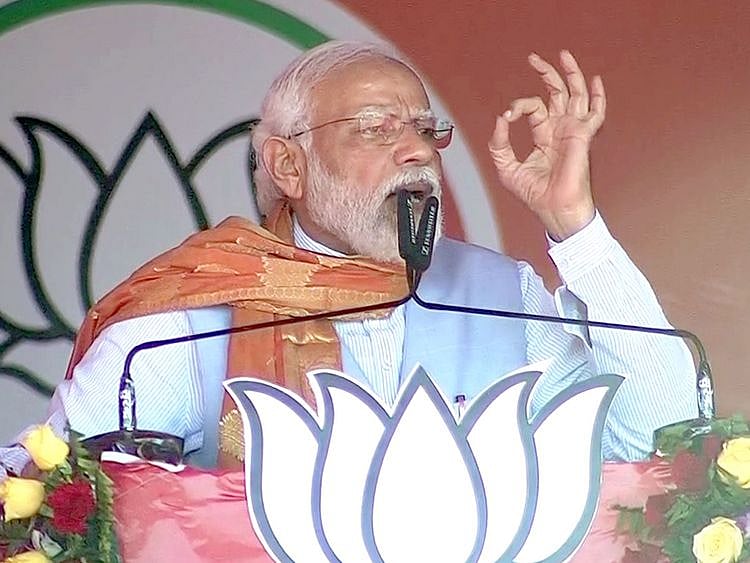Elections 2022: ‘If BJP loses UP, India’s opposition will be galvanised’
Ruling party has attracted newer classes of voters, top social scientist tells Gulf News

Votes for assembly elections in five Indian states — Uttar Pradesh, Goa, Manipur, Punjab, and Uttarakhand — are being counted on March 10. These results will have a massive impact on the country’s polity.
Gulf News caught up with Dr Nalin Mehta, noted social scientist, journalist, and author to get a lowdown on these crucial results.
Mehta’s new book The New BJP: Modi and the Making of the World's Largest Political Party is considered a classic in non-fiction. It covers the evolution and rise of Bharatiya Janata Party (BJP) with the help of enormous data never unearthed before and extensive field work. It is a must-read book for anyone interested in understanding how Narendra Modi’s party became the world’s largest political party.
What is your take on the ongoing debate that the BJP may find it difficult if the election turns “forwards versus backwards”? Does BJP get nervous without religion-based polarisation?
The BJP’s electoral advances in Uttar Pradesh in the 2014, 2017 and 2019 elections were built on its successful forging of a wider social coalition which brought in large numbers of Other Backward Classes (mostly non-Yadav OBCs) and, to a lesser extent, non-Jatav Dalits.
Its success in 2022 hinges on how many of these new voters the party retains. Polarisation has historically helped the BJP in elections, especially in minority-dominant areas because of counter-mobilisation. While Hindutva mobilisation is crucial to the BJP’s imagery, social engineering played a major role in its growth.
Nationally how do you see significance of the 2022 UP election for the BJP?
BJP’s rise as India’s predominant political party since 2014 is powered by its huge advances in the Hindi heartland generally and, more specifically, by its dominance in Uttar Pradesh. This UP election is hugely significant as it follows two years of economic hardship with the pandemic, lockdowns and the farmers agitation.
If Yogi Adityanath’s government wins a second term, he will be the first chief minister of the state since independence to be returned to power for back-to-back terms. This will make him the party’s most influential chief minister with significant implications for national politics.
Prime Minister Narendra Modi, of course, remains India’s most popular national leader by a margin. This verdict will also be seen as an important political signal nationally. If the BJP loses, it will galvanise the opposition nationally as we head to the 2024 national election.
Will you call the BJP a secular party or Hindu nationalist party or just a pro-Hindu party? Is BJP seriously pursuing an idea of making India a Hindu Rashtra?
The BJP’s political identity has been steeped in Hinduness — right from the birth of its predecessor, the Jan Sangh, in the 1950s. From Atal Bihari Vajpayee’s call for ‘positive secularism’ in the 1980s to LK Advani’s jibe at what he called the Congress’s ‘pseudo-secularism’ to the Ram Temple movement, the BJP has been consistent on this issue.
But the political advances of the new BJP since 2014 have been built on the fact that it has attracted newer classes of voters — cutting across divides of caste, class and gender — over and above the core constituency of Hindutva. As a UP government official told me, Hindutva gives the BJP’ wheel speed, but the wheel that drove its expansion is welfare.
How much is BJP influenced, reshaped and driven by the individuals like L.K. Advani, Atal Bihari Vajpayee and Narendra Modi? How much by ideology?
The party’s ideology on core issues has remained constant since the 1950s. What has changed is that it is now electorally acceptable to much larger numbers of Indians.
Personalities matter. There is no question that Narendra Modi spearheaded the BJP’s transformation into the primary pole of Indian politics as well as the world’s largest political party.
Many political observers think BJP has radically changed under the leadership of Modi and Shah. Do you agree? What has changed and how?
The new BJP refashioned by Narendra Modi, and Amit Shah, is very different from the pre-2014 BJP. The old BJP was largely an urban, upper-caste ‘brahmin-bania’ party.
The new BJP retained urban support but also became the predominant rural party in north India, with a much wider social base. The entry of large number of OBCs and non-Jatav Dalits into the party’s social composition and, crucially, the making of a new women’s vote powered the BJP’s growth.
While writing the book which are the insights and anecdotes you got that surprised you?
I am a political junkie but 80-90 per cent of what’s in the book I did not know before I started working on it. For example, the usage of new Artificial Intelligence and machine learning technique with the Narad Index, which we constructed by digitising over 11,500 BJP-linked documents between 2006-19, allowed us to see patterns of party communications that would otherwise have been missed.
It showed how the BJP differentiated its messaging to different audience over time to communicate beyond the core Hindutva vote. In 2019, for instance, BJP external messaging focused more on farmers and development than its core ideological issues.
What if BJP loses UP election? How will it face the challenge of 2024 election?
National elections are different from state contests but the symbolism of any possible reverse in UP will be huge. If that happens then party may have to do some course-corrections as it gears up for 2024.
Network Links
GN StoreDownload our app
© Al Nisr Publishing LLC 2025. All rights reserved.